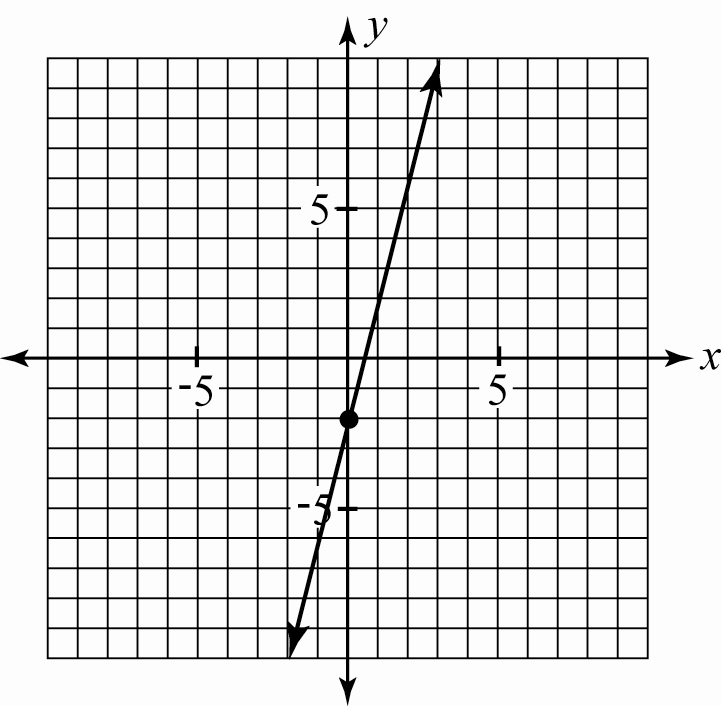Study Guide: 8-5-3. Linear Functions
Vocabulary
| Term | Description |
|---|---|
| Cartesian Plane | a two-dimensional plane divided into four quadrants using x- and y-axis |
| Origin | the point of intersection of the x-axis and y-axis on a Cartesian Plane |
| Function | a relationship between variables that has one output for each and every input |
| Linear Function | a function that is represented by a line when graphed on a Cartesian Plane |
| Domain | the set of input values or x-values of a function |
| Range | the set of output values or y-values of a function |
| Slope | a ratio of the rate at which the dependent variable is changing versus the rate at which the independent variable is changing; frequently expressed as $\frac{RISE}{RUN}$, or $\frac{\textit{The change in y}}{\textit{The change in x}}$ |
| Slope-Intercept form | the form $y = mx + b$ of a linear equation, where m represents the slope of the line and b represents its y-intercept |
| Point-Slope form | the form $y - y_1 = m(x - x_1)$ of a linear equation, where m is the slope, and $y_1$ and $x_1$ are the coordinates of a point. |
| x-intercept | the point on the x-axis where the line of a function crosses the x-axis |
| y-intercept | the point on the y-axis where the line a function crosses the y-axis |
| Absolute Value | the distance a number is from zero on a number line (distance is never negative) |
Questions
-
Which point is on the y-access?
- (1, 0)
- (0, 1)
- (-1, -1)
- $\left(\frac{1}{2}, 0\right)$
-
Which point is on the x-access?
- (1, 0)
- (0, 1)
- (-1, -1)
- $\left(\frac{1}{2}, 0\right)$
-
Which point is an y-intercept?
- (1, 0)
- (0, 1)
- (-1, -1)
- $\left(\frac{1}{2}, 0\right)$
-
Which point is a x-intercept?
- (1, 0)
- (0, 1)
- (-1, -1)
- $\left(\frac{1}{2}, 0\right)$
-
What is a good visual test for a linear function?
- A vertical line
- An infinite line
-
Which of the following CAN NEVER be a linear function?
- A horizontal line
- A straight line
- A vertical line
- An infinite line
-
Which set of ordered pairs satisfies a linear function?
- { (5 ,1), (4 , 4), (3, 9), (2 , 16), (1 25) }
- { (1, -5), (2 , -3), (3, -1), (4 , 1), (5, 3) }
-
Which set of ordered pairs is an arithmetic sequence?
- { (5 ,1), (4 , 4), (3, 9), (2 , 16), (1 25) }
- { (1, -5), (2 , -3), (3, -1), (4 , 1), (5, 3) }
-
Convert to Standard Form: $y=2x+1$
-
What is the Standard Form of a linear function?
-
What is the Slope-Intercept Form of a linear function?
-
Which is NOT true about the Standard Form?
- The variable are written in alphabetical order.
- The x variable must always be positive.
- Fractions are NOT allowed.
- The y variable must always be positive.
-
What is the Slope Formula?
-
Why is it so easy to plot lines using x- and y-intercepts?
-
Which is true about a positive slope?
- The line goes up and to the right.
- The line is horizontal.
- The line goes down and to the right.
- The line is vertical.
-
Which is true about a negative slope?
- The line goes up and to the right.
- The line is horizontal.
- The line goes down and to the right.
- The line is vertical.
-
Which is true about a zero slope?
- The line goes up and to the right.
- The line is horizontal.
- The line goes down and to the right.
- The line is vertical.
-
Which is true about an undefined (or infinite) slope?
- The line goes up and to the right.
- The line is horizontal.
- The line goes down and to the right.
- The line is vertical.
-
Find the slope of a line with points (-2, -1) and (4, 2).
-
Find the slope of a line with points (0, 2) and (4, -1).
-
Write equations in Standard Form representing each of the following:
- A positive slope.
- A negative slope.
- A horizontal line.
- A vertical line.



